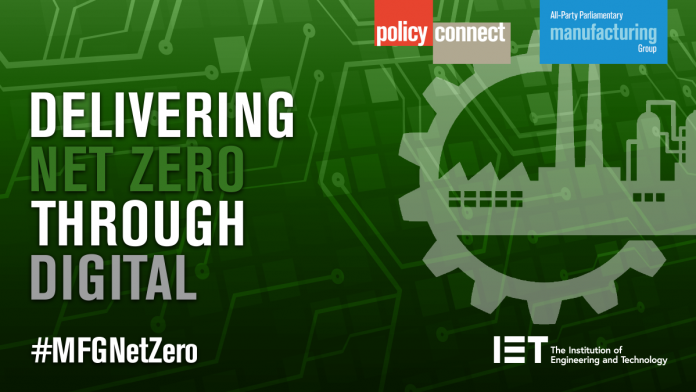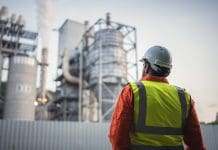A new report from the All-Party Parliamentary Manufacturing Group is calling for policy, tax incentives and support to be better targeted in order to drive investment in green manufacturing. Floriane Fidegnon, head of industry, technology and innovation at Policy Connect, looks at how this could impact on construction
In February 2022, the All-Party Parliamentary Manufacturing Group (APMG) published its latest short report, Delivering Net Zero through Digital, in partnership with the Institution of Engineering & Technology (IET).
Through an inquiry process which convened senior leaders in manufacturing, the APMG identified three key areas where industrial, environmental and innovation policy align.
Specifically, the inquiry addressed questions around how the UK can finance a net zero future across all manufacturing subsectors, from the largest companies in the supply chain to the vital SMEs that provide specialist and specific products.
The recommendations are simple:
- The range of support service offers to manufacturers must be mapped and promoted. This will enable all companies to access the help they need to transform their processes, plant and operations.
- All government funding and tax reliefs, particularly capital allowances, from now until 2050 should be used to incentivise investment in green technologies and more sustainable manufacturing methods. The APMG highlighted the recent Super Deduction allowance, but there is scope for this principle to apply to several tax rebates.
- Alongside the net zero strategy, businesses should be encouraged to create their own sustainability roadmaps, outlining how their organisation will become more sustainable, secure in the future net zero demand.
The impact on construction
The key question is what this means for engineering and construction.
Creating a more sustainable built environment sector can be distilled largely into two discrete aspects: more efficient manufacturing methods and the retrofitting of old buildings.
There are key opportunities for the sector within both aspects.
In achieving more efficient manufacturing methods, there is demand for buildings built using modular and offsite methods. Taking on the retrofitting challenge will require tackling the scale at which buildings need to be futureproofed but provides an opportunity for the sector to become more sustainable.
Both aspects will need the sector to invest in new equipment technologies and methods incentivised by demand, as well as the support and leadership to implement these changes at the required rate.
How does digitalisation help?
Digitalisation is a key tool for industry as it allows us to visualise and identify waste in our processes and work to become more efficient.
Data is often siloed in construction, precluding the integration of all information and making it readily available so continuous improvement can be achieved. Here, the key solution is building capability in your workforce and providing them with the access to external advisory support, which can be low cost and low effort. In turn, this upskilling will allow employees to use this knowledge to change and improve their processes.
Digitalisation can be highly customisable and achieved on projects of all sizes. Fundamentally, its use on construction sites can support practitioners seeking to reduce waste, increase resource efficiency and create buildings that meet the latest sustainability certification.
In wider Policy Connect work, we have identified a few ways that construction policy can support the construction industry, facilitating collaboration and ensuring that there is a harmonisation of how digital technologies are being used to create more sustainable buildings. With BIM leading the way in how practitioners can better visualise their processes, other advanced techniques such as the Internet of Things, digital twins, process digitisation and augmented reality present an exciting new way to create the buildings of the future.
Achieving digitalisation will require a whole-systems approach and will need to become part of the support offered to the sector via catapults, trade bodies, associations and advisory services. Policymakers must also understand that it is not just new builds that will have an impact but also existing building stock that will need to be brought up to code. Retrofit will therefore be central to delivering net zero.
Financing net zero
With small margins of profit, it is often the case that there is little breathing room to invest in new and experimental technologies. Capital expenditure on drones, robotics, additive manufacturing and virtual reality equipment can be difficult to justify if there is no medium-term return on investment. Government can support this by using schemes such as the Super Deduction to encourage investment in the technologies the sector needs to become more sustainable.
Consumers are also driving the change for digitalisation in the built environment through demand for zero-carbon homes. Customer-facing innovations, such as tablets, pre-loaded with a building’s digital model can not only deliver on increased demand for sustainable homes but can also improve building safety by improving transparency and traceability of construction materials. The other consideration is how tax rebates can incentivise pull from home and commercial building owners and create demand for more sustainable buildings. For example, could VAT rebate on insulation materials encourage investment in retrofitting for the long term?
With legally binding 2050 targets in mind, this is a key opportunity to get businesses back on track and align their processes with net zero ambitions. Implementing a “green” eligibility criterion for capital allowances will stimulate the know-how and culture to introduce and exploit low-carbon/zero-carbon technologies. The return on investment in this case is not just the income that is generated but equipping the sector to start delivering net zero targets. If the targets are to be met, action in this decade is critical.
Green business plans
Already we see the financial sector, developers and clients adopting Environmental Sustainability and Governance principles. As time goes on, we expect to see more businesses looking for ways to demonstrate their sustainability. Crucially, we must see synergies between government’s decarbonisation roadmap and industry’s ability to match pace. Levels of readiness to achieve net zero will rely heavily on these highly skilled specialist SMEs, who although adaptable, will need be given certainty, through the government’s roadmap, on how they need to plot the course for their business between now and 2050.
Conclusion
There are undeniably big changes to come for the construction and offsite manufacturing sectors as the implications of decarbonisation become clear. As industry works to meet demand and the new challenges of net zero, government and policy should be there to support.
To read the full report visit – https://www.policyconnect.org.uk/research/delivering-net-zero-through-digital.
Floriane Fidegnon is the head of Industry, Technology and Innovation at Policy Connect, leading the work of the All-Party Parliamentary Manufacturing Group. With thanks to Rick Hartwig at the Institution of Engineering and Technology.

Floriane Fidegnon
Head of industry, technology and innovation
Tel: +44 (0)207 202 8585














